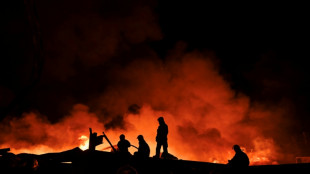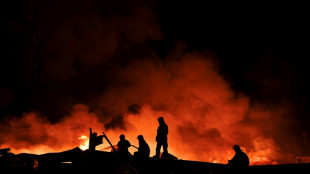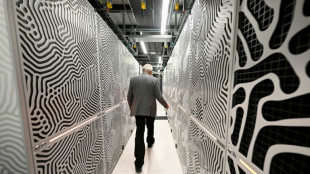-
 Ford steers England to rare win over New Zealand
Ford steers England to rare win over New Zealand
-
Massive march in Brazil marks first big UN climate protest in years

-
 Spain rescues hundreds of exotic animals from unlicensed shelter
Spain rescues hundreds of exotic animals from unlicensed shelter
-
Huge fire sparked by explosions near Argentine capital 'contained'

-
 South Africa defy early red card to beat battling Italy
South Africa defy early red card to beat battling Italy
-
Sinner beats De Minaur to reach ATP Finals title match

-
 Zelensky vows overhaul of Ukraine's scandal-hit energy firms
Zelensky vows overhaul of Ukraine's scandal-hit energy firms
-
South Africa defy early red card to beat Italy

-
 Alex Marquez claims Valencia MotoGP sprint victory
Alex Marquez claims Valencia MotoGP sprint victory
-
McIlroy shares lead with Race to Dubai title in sight

-
 Climate protesters rally in Brazil at COP30 halfway mark
Climate protesters rally in Brazil at COP30 halfway mark
-
Spike Lee gifts pope Knicks jersey as pontiff meets film stars

-
 BBC caught in crossfire of polarised political and media landscape
BBC caught in crossfire of polarised political and media landscape
-
'Happy' Shiffrin dominates in Levi slalom for 102nd World Cup win

-
 Palestinian national team on 'mission' for peace in Spain visit
Palestinian national team on 'mission' for peace in Spain visit
-
Brazilian 'Superman' cheers child cancer patients in Ghana

-
 India close in on win over South Africa after Jadeja heroics
India close in on win over South Africa after Jadeja heroics
-
Huge explosions rock industrial area near Argentina's capital

-
 Bezzecchi takes pole for Valencia sprint and MotoGP
Bezzecchi takes pole for Valencia sprint and MotoGP
-
Dominant Shiffrin leads after first slalom run in Levi

-
 Nine killed in accidental explosion at Indian Kashmir police station
Nine killed in accidental explosion at Indian Kashmir police station
-
Climate protesters to rally at COP30's halfway mark

-
 Fighting South Africa lose Rickelton after India 189 all out
Fighting South Africa lose Rickelton after India 189 all out
-
Harmer leads South Africa fightback as India 189 all out

-
 Prison looms for Brazil's Bolsonaro after court rejects his appeal
Prison looms for Brazil's Bolsonaro after court rejects his appeal
-
EU bows to pressure on loosening AI, privacy rules

-
 India close in on lead despite South African strikes
India close in on lead despite South African strikes
-
Curry's 49 points propel Warriors in 109-108 win over Spurs

-
 NZ boxer Parker denies taking banned substance after failed test
NZ boxer Parker denies taking banned substance after failed test
-
Australia setback as Hazlewood ruled out of 1st Ashes Test

-
 Australia pace spearhead Josh Hazlewood ruled out of 1st Ashes Test
Australia pace spearhead Josh Hazlewood ruled out of 1st Ashes Test
-
UN Security Council to vote Monday on Trump Gaza plan

-
 Japan's Tomono leads after men's short program at Skate America
Japan's Tomono leads after men's short program at Skate America
-
China tells citizens to avoid Japan travel as Taiwan row grows

-
 Purdue Pharma to be dissolved as US judge says to approve bankruptcy
Purdue Pharma to be dissolved as US judge says to approve bankruptcy
-
Iran's first woman orchestra conductor inspires

-
 Wood gets all-clear in boost for England
Wood gets all-clear in boost for England
-
Golf's world No. 8 Thomas has back surgery

-
 Rebooted Harlem museum celebrates rise of Black art
Rebooted Harlem museum celebrates rise of Black art
-
'Desperation in the air': immigrant comics skewer Trump crackdown

-
 UN regulator says shipping still wants to decarbonize -- despite US threats
UN regulator says shipping still wants to decarbonize -- despite US threats
-
Grant, Kim share halfway lead in LPGA Annika tournament

-
 Musk's Grokipedia leans on 'questionable' sources, study says
Musk's Grokipedia leans on 'questionable' sources, study says
-
Trump signs order to lower tariffs on beef, coffee, other goods

-
 Croatia qualify for 2026 World Cup, Netherlands close, Germany in limbo
Croatia qualify for 2026 World Cup, Netherlands close, Germany in limbo
-
'Last Chance U' coach dies after shooting: US police

-
 Sinner completes perfect ATP Finals group stage, Auger-Aliassime reaches last four
Sinner completes perfect ATP Finals group stage, Auger-Aliassime reaches last four
-
Woltemade sends Germany past Luxembourg in World Cup qualifier

-
 Croatia qualify for 2026 World Cup with 3-1 win over Faroes
Croatia qualify for 2026 World Cup with 3-1 win over Faroes
-
Kai Trump makes strides but still misses cut in LPGA debut

Vera Rubin observatory reveals stunning first images
Breathtaking stellar nurseries, a sprawling stretch of cosmos teeming with millions of galaxies, and thousands of newly discovered asteroids were revealed Monday in the first deep space images captured by the Vera C. Rubin Observatory in Chile.
More than two decades in the making, the $800 million US-funded telescope sits atop Cerro Pachon in central Chile, where dark skies and dry air provide ideal conditions for observing the cosmos.
One debut image is a composite of 678 exposures taken over seven hours, capturing the Trifid and Lagoon Nebulae -- both several thousand light-years from Earth -- glowing in vivid pinks against orange-red backdrops.
It reveals these birth places of stars in unprecedented detail, with previously faint or invisible features now clearly visible.
Another, dubbed "The Cosmic Treasure Chest," shows the universe "teeming with stars and galaxies -- the seemingly empty black pockets of space between stars in the night sky when you look at it with unaided eyes, are transformed here into these glittering tapestries," said Zeljko Ivezic, director of Rubin construction.
Spiral, elliptical, and clustered galaxies appear in vivid reds, blues, and oranges. These colors reveal key details such as distance and size with unmatched precision, helping scientists better understand the universe's expansion history.
The colors don't directly match what the naked eye would see, explained scientist Federica Bianco, since the telescope captures a far broader range of wavelengths. Instead, they are representational: infrared is mapped to red to represent cooler objects, while ultraviolet is mapped to blue and indicates warmer ones.
- 10-year flagship project -
An interactive version of the image is now available on the Rubin Observatory's website.
"One of the things that is very fun is that if you zoom in and you look at one of the fuzzy galaxies there, you might be the first person to be paying attention to that fuzzy blob," said Clare Higgs, education and public outreach science lead.
The observatory features an advanced 8.4-meter telescope and the largest digital camera ever built, supported by a powerful data system transferring 20 terabytes each night.
Roughly the size of a car, the camera captures 3,200-megapixel images. It would take 400 ultra-high-definition televisions stacked together to view a single Rubin image at full resolution.
Later this year, the observatory will launch its flagship project, the Legacy Survey of Space and Time (LSST). Over the next decade, it will scan the night sky nightly, detecting even the subtlest changes with unmatched precision.
Named after pioneering American astronomer Vera C. Rubin — whose research provided the first conclusive evidence for dark matter — the observatory continues her legacy by making dark matter a central focus of its mission.
Dark energy, an equally mysterious and immensely powerful force, is believed to drive the accelerating expansion of the universe. Together, dark matter and dark energy are thought to make up 95 percent of the cosmos, yet their true nature remains unknown.
"By observing up to 20 billion galaxies, we'll study how light from those distant galaxies has reached us — and nearly every galaxy's light has been bent by the gravitational interaction of dark matter that pervades the universe," said scientist Aaron Roodman. This, he added, will help illuminate these cosmic mysteries.
A joint initiative of the US National Science Foundation and Department of Energy, the observatory is also considered one of the most powerful tools ever built for planetary defense.
In just 10 hours of observation, Rubin discovered 2,104 previously unknown asteroids in our solar system, including seven near-Earth objects -- none of which pose a threat. All other ground- and space-based observatories combined discover about 20,000 new asteroids per year.
- Chilean pride -
Chile hosts telescopes from more than 30 countries, including some of the most advanced astronomical instruments in the world — among them the ALMA Observatory, the most powerful radio telescope on Earth.
Cerro Tololo Observatory helped achieve the landmark discovery of the universe's accelerating expansion -- a breakthrough that earned the 2011 Nobel Prize in Physics.
Another major project, the Extremely Large Telescope, is slated to begin operations in 2027 and promises to probe previously unreachable cosmic distances.
D.Qudsi--SF-PST


